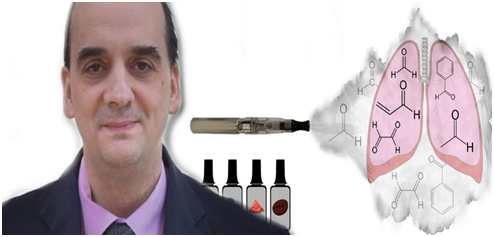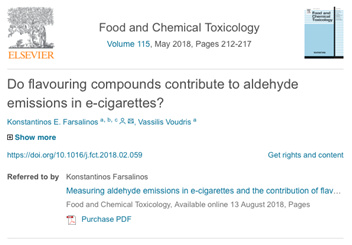
Following the result of a study carried out by Andrey Khlystov and Vera Samburova in 2016, The Sun published the proof that “E-cigs can kill”. However, this study was widely criticized due to its poor methodology. Again, the study was perceived to only focus on dry-burning and rather than the normal vaping conditions.
Subsequently, a replica research was carried out by Farsalinos and Vassilis Voudris in which they failed to replicate the findings. Consequent to this, they published a Food and Chemical Toxicology paper in May, titled ‘Do flavoring compounds contribute to aldehyde emissions in e-cigarettes?’ The following were stated in the paper:
- This replication study found aldehyde emissions to be up to 589-fold lower compared to the previous report.
- A recent study found that the major source of aldehyde emissions in e-cigarettes are flavorings.
- There were only minimal differences between unflavored liquids and flavored.
Unflavored liquids also emitted aldehydes using the same e-cigarette devices.

Despite detecting the presence of formaldehyde, Farsalinos and Voudris went ahead to state that ‘the absolute levels were minimal.’
In response to the disproof and criticism from the duo, Khlystov and Samburova issued a letter clearly stating the motive in their previous study. They wrote: “We aim at is to pointing out and/or correcting the inaccuracies and inconsistencies in that paper.” They further stated that “Farsalinos and Co made several outright false and misleading statements”. Again, the methods adopted by Farsalinos and coworker in the replica study were not suitable for e-cigarette aerosols studies.” They also went on to justify their adoption of a flawed research methodology. They also added that Farsalinos and Voudris had ulterior motives for trying to falsify the result of experiments that discovered vast quantities of formaldehyde.
In response to these statements by Khystov and Samburova, Dr. Farsalinos produced a fourteen-page document. In his paper, Dr. Farsalinos stated thus;
“Lack of concrete evidence and verification that dry puffs were avoided and that feasible conditions were tested in the laboratory settings provides one of the major issues here. This phenomenon, which every e-cigarette user understands, knows and detects, has been largely neglected by researchers,” He went further to state thus; “only 4 out of the 32 studies were identified by a systematic review to have controlled the experimental conditions for the generation of dry puffs.” In addition, he made it clear that the asking experienced vapers to test the e-cigarette equipment (devices and liquid) at the power settings and puffing parameters that will be used in the laboratory was the only satisfactory way to ensure test conditions meet normal vaping conditions “
Farsalinos went further explain that wattage alone is no indication of the potential for overheating because different coils heat at different rates. Secondly, he pointed out that the rate at which the wick conveys liquid to the coil determines the time between puffs. Thirdly, he added that a dry-burn condition will result if there is insufficient puffing at high power settings over a prolonged time frame.
Farsalinos also laid emphasis on the importance of the modern atomizers for such kind of research instead of the outdated ones, especially when using conditions replicating direct lung inhales. In a quote, he also stated that Khlystov and Samburova seemed to consider power as the only parameter determining aldehyde emissions, ignoring other important characteristics such as the design of the atomizers and consistency in production quality.
Farsalinos also made it clear that Khlystov and Samburova failed to acknowledge that fact that the analyses and replica study was carried out in the Gillman and Enthalpy Analytical laboratory as were stated in the Acknowledgement and Materials and methods sections of their research manuscript Gillman et al. (2016).
He went further to contend the irrelevance of Khlystov and Samburova debates on the emission and performance of the CE4 atomizers. He made it clear that the CE4s are obsolete and have not been used in any numbers tracing back to the advent of vaping.
Farsalinos also stated that Khlystov and Samburova displayed a high level of inconsistency in their acceptance and rejection of measurements. This made them guilty of selectively accepting results based on the values reported. He further noted that the duo should carefully review the literature to have a clear understanding of the complexities as well as the various parameters which could have an effect on the study results before making insulting and unjustifiable conclusions about other scientists.
Farsalinos went further to state that the duo authors should have carefully and thoroughly read the cited documents representing the accreditation of the laboratory they used because these documents completely reject their study findings. He also carefully went through their work and highlighted how the data contradicts the unconfirmed levels the duo scientists discovered in their study.
Farsalinos also buttressed that fact that no study, so far, have documented their findings which further raises questions about the validity of their work. He also laid the ground for possible retraction of their papers since their methodology appeared more like a hit and miss strategy.
Finally, Farsalinos concludes by saying that Dr. Khlystov’s conduct and his repeated denial of using liquid brand needs to be noticed. He then concludes with the following:
- •There is no scientific basis in the arguments used by used by Khlystov and Samburova
- •Some of their citations perfectly agree with our findings
- •The studies cited strongly reject their findings
- •They showed several inconsistencies in accepting in one case and rejecting in another
- •They make scientifically unjustified and unsubstantiated assumptions
- •They compared their study studies with those evaluating dry puffs where no actual dry puffs were created
- •They seem to ignore or underestimate the complexity of the e-cigarette functional parameters
- •Most importantly, their findings cannot be attributed to dry puffs because they are inconsistent with current literature. This makes the calls for retraction justified and more relevant as it raises even more questions about their scientific validity.
It’s indeed a delicate argument from Khlystov and Samburova and damning destruction of the experiments. Beyond just an academic point scoring, Farsalino’s response is meant for other researches to read and incorporate into their future research planning stages.
